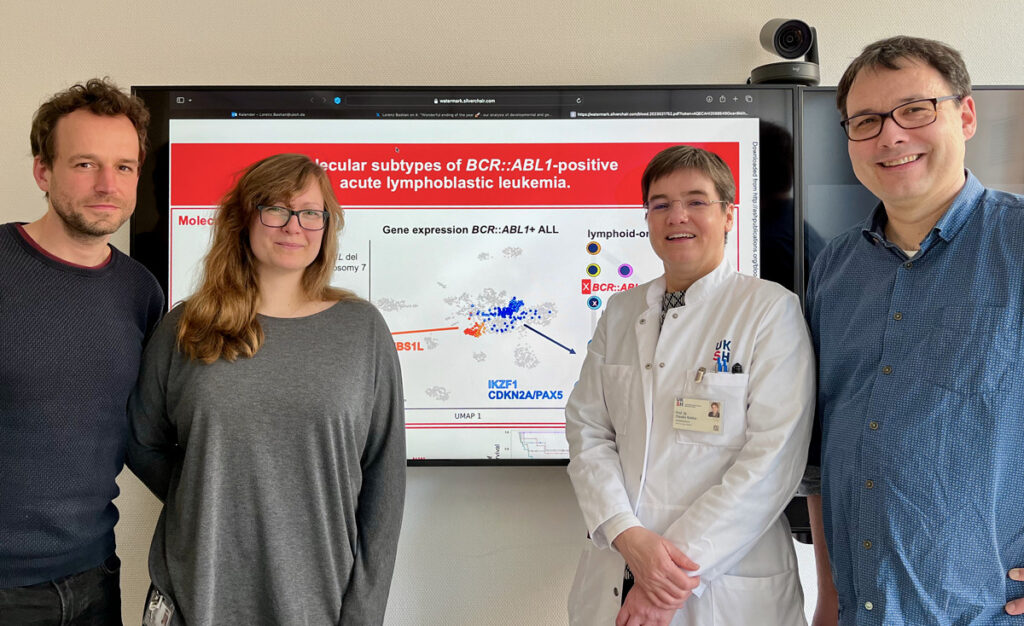New Prognostic Subtypes in BCR::ABL1-positive ALL: Applying Machine Learning Approaches for Precision Medicine
In collaboration with international colleagues, researchers from the University Clinic Schleswig-Holstein (UKSH), Campus Kiel and Kiel University, have developed a new predictive model for the systematic classification of BCR::ABL1-positive acute lymphoblastic leukemia (ALL).
BCR::ABL1 is the most frequent driver aberration in adult ALL patients, especially at advanced age. Emerging treatment concepts involve combining specific tyrosine kinase inhibitors with significantly reducing reliance on traditional chemotherapy. First clinical trials even explore chemotherapy-free treatments. Resistance mechanisms such as loss of lineage identity and immunotherapy-marker negative relapse are recognized challenges in immunotherapies, emphasizing the need for early identification of suitable candidates. Furthermore, the BCR::ABL1 driver fusion is observed in non-lymphatic cell types in a third of BCR::ABL1-postive ALL patients. This suggests a vulnerability towards lineage transition and defines two diagnostic categories: the ‘lymphoid only’ versus multilineage, BCR::ABL1-positive ALL. However, systematic diagnostic standards for this classification are yet to be established.

Lorenz Bastian, MD, from UKSH, and principal investigator of the DFG-funded clinical research unit 5010 CATCH ALL, along with colleagues, analyzed the largest dataset available for this entity comprising 327 BCR::ABL1-positive ALL patients aged 2 to 84 years. Employing an unsupervised machine learning approach, researchers identified gene expression signatures which defined the BCR::ABL1 multilineage versus lymphoid-only ALL subtypes. Moreover, two gene expression subclusters were identified within these two main subtypes. Further analysis revealed distinct genomic aberration patterns in each of the four subclusters. The results of this study were recently published in the renowned journal ‘Blood’.
In the multilineage subclusters, focal deletions in the HBS1-like translational GTPase (HBS1L) were strongly enriched in one subcluster (‘delHBS1L’), while monosomy 7 was highly prevalent in the other subcluster (‘del7’). On the other side, the lymphoid subclusters were either enriched for homozygous deletions in IKZF1 (‘IKZF1’) or for homozygous CDKN2A/B deletions, PAX5 deletions, and/or hyperdiploidy (‘CDKN2A/PAX5’). A deeper analysis of specific phenotypes revealed distinct underlying developmental trajectories, with the multilineage clusters showing higher proximity to earlier stages of B cell development in contrast to a more mature cell-of-origin for the lymphoid clusters.
The newly identified BCR::ABL1 ALL clusters, notably CDKN2A/PAX5 in pediatric patients and multilineage cases in the elderly, presented distinct clinical profiles. Examination of 98 patients on “German Multicenter Study Group for Adult Acute Lymphoblastic Leukemia” (GMALL) protocols showed comparable three-year disease-free survival (DFS) rates for multilineage and lymphoid clusters with 100% DFS in hyperdiploid cases. This renders the BCR::ABL1 ALL subclusters prognostic factors for ALL patients; however, further trials would be needed to ultimately evaluate the role of BCR::ABL1 subtypes in the context of chemotherapy-free treatments relying on immunotherapy targets.
Prof. Claudia Baldus, MD, speaker of the clinical research group CATCH ALL and head of the internal medicine II at the UKSH said, “These results contribute significantly to our understanding of the age-related factors in ALL. Future research should prioritize evaluating immunotherapies within the context of these recently identified subtypes. The success of blinatumomab, particularly when combined with TKIs, highlights the need to explore the response of BCR::ABL1 multilineage cases to treatments targeting the CD19-positive lymphoid compartment. Identifying BCR::ABL1 ALL subtypes in ongoing trials is essential for refining existing therapeutic strategies, encompassing both lineage-specific and lineage-independent approaches. Our tool, ALLCatchR, is now trained to efficiently identify these new BCR::ABL1 ALL clusters, facilitating further developments in this area.”
Dr. Bastian emphasized: “These data show the benefits of transcriptome sequencing for ALL patients, being currently the only method for unsupervised diagnosis across all ALL subtypes in hematologic disease classification and providing insights into disease biology and outcome. As a result, we have integrated transcriptome sequencing into routine diagnostics at Hämatologielabor Kiel.”
Text: Dr. Claudia Taubenheim
Original publication
Bastian L, Beder T, Barz MJ, Bendig S, Bartsch L, Walter W, Wolgast N, Brändl B, Rohrandt C, Hansen BT, Hartmann AM, Iben K, Das Gupta D, Denker M, Zimmermann J, Wittig M, Chitadze G, Neumann M, Schneller F, Fiedler W, Steffen B, Stelljes M, Faul C, Schwartz S, Müller FJ, Cario G, Harder L, Haferlach C, Pfeifer H, Gökbuget N, Brüggemann M, Baldus CD; Developmental trajectories and cooperating genomic events define molecular subtypes of BCR::ABL1-positive ALL. Blood (2024) 143 (14): 1391–1398. doi: https://doi.org/10.1182/blood.2023021752
